
Oswald, Horace and Eustace Short
 Oswald (1883-1970), Horace (1872-1917) and Eustace Short (1875-1932)
The Short brothers founded Britain's first aircraft factory. In 1909 they were building their first six Short-Wright biplanes under license. The company later changed it's name to Short Brothers and Harland.
Oswald, Horace and Eustace Short In 1897 brothers Eustace (1875-1932) and Oswald Short (1883-1970) began their collective aviation career as self-learned pilots of the coal-gas balloon. After a relatively short amateur ballooning career, in 1905, they provided three balloons by contract to the Indian army; shortly thereafter they found their way into the public sector of aviation, manufacturing balloons for other independent adventurers like themselves. Then, in 1908, brother Horace Short (1872-1917) joined Eustace and Oswald in the family business and the three officially adopted the company name of Short Brothers. Following these developments, the newly formed company began production in the town of Leysdon on the Isle of Sheppey where the Short Brothers became the first aircraft builders in the world. Although Great Britain's Civil Air Transport Committee had recognized in 1917 (over ten years after the Shorts began their business exploits) the civilian need for flights to remote destinations, such as South Africa and India, it was not for another ten years that the necessity would be fulfilled. The airboat (flying boat) presented a whole new means of travel for adventurous Europeans. Equipped for water landings, the flying boat allowed access to new and highly romanticized destinations that were now in demand.
Other mentions of the Short Brothers Between 1909 - 10 the Short Brothers who were based at Leysdown on the Isle of Sheppey in the UK, built six Wright flyers under contract. This marked the beginning of the British Aviation manufacturing industry. The aircraft were supplied to the Royal Aero Club. http://www.rochesterairport.flyer.co.uk
Initially confined to ballooning, when heavier-than-air flight arrived, the Club (Royal Aero Club) embraced it with alacrity. The Club established its first flying ground at Muswell Manor near Leysdown on the Isle of Sheppey in 1909. Early contacts with the Wright brothers in America by Charles Rolls and the redoubtable Short brothers, balloon makers to the Club, led to the latter acquiring a Wright license and laying down the first aircraft production line in the world, at Leysdown and later nearby at Eastchurch. http://www.royalaeroclub.org
From the start of this century ballooning was established as a sport. Oswald and Eustace Short made their first balloon in 1898 and established their works under a Battersea railway arch, supplying all fitments for the sport. From 1908 Oswald and Eustace were joined by their elder brother [Horace] and set up one of the first aircraft-manufacturing companies. http://www.sciencemuseum.org.uk
The Short Brothers (Rochester & Bedford) Ltd. was founded by two brothers, Eustace and Oswald Short in 1898, in England. Originally they manufactured spherical balloons then in 1907 the firm was appointed Official Aeronautical Engineers to the Royal Aero Club. In 1913, the company found further development necessary and devoted itself almost entirely to the manufacture of seaplanes. Since the War, the Short Bros. achieved great success in developing these all metal flying boats. http://collections.ic.gc.ca
The airship was invented in 1852 by Frenchman Henri Giffard. The first hydrogen-filled airship flew in September of that year, and this was followed by the famous Zeppelins in 1890. Between 1900 and 1939 the airship was a huge success, and during this time in 1917 the Short Brothers began to build a factory and shed for the manufacture of the government sponsored R.101 Airship, at Cardington in Bedfordshire. In 1928, a second shed was brought from Norfolk, for the privately built R.100 Airship. These two gigantic buildings still dominate the village today. Pulham St. Mary in Norfolk was home of one of the world's greatest airship stations between 1915-1935. The R.33 Airship is portrayed on the village sign. In 1930 the R101, while on its maiden voyage, was buffeted by high winds and crashed over France, only six of its fifty-four passengers and crew survived. As a result airship production was ceased. http://www.eastofenglandtouristboard.com
In April 1901, Oswald and Eustace Short started to manufacture balloons in Hove, Sussex. By 1908 they had been joined by their brother Horace, moved to London and began to develop heavier than air machines. When larger premises were needed, the company moved to Eastchurch and later Rochester. In 1937, a factory to build aircraft was set up with the shipbuilders Harland and Wolff in Belfast harbour. The company headquarters was moved to Belfast in 1948. http://web.ukonline.co.uk
The Mastery of The Air
Aeroplanes and Airmen : Sea-Planes for Warfare
"Even in the region of the air, into which with characteristic British prudence we have moved with some tardiness, the Navy need not fear comparison with the Navy of any other country. The British sea-plane, although still in an empirical stage, like everything else in this sphere of warlike operations, has reached a point of progress in advance of anything attained elsewhere.So said Mr. Winston Churchill at the Lord Mayor's Banquet held in London in 1913, and I have quoted his speech because such a statement, made at such a time, clearly shows the attitude of the British Government toward this new arm of Imperial Defence. In bygone days the ocean was the great highway which united the various quarters of the Empire, and, what was even more important from the standpoint of our country's defence, it was a formidable barrier between Britain and her Continental neighbours, "Which serves it in the office of a wall Or as a moat defensive to a house." But the ocean is no longer the only highway, for the age of aerial navigation has arrived, and, as one writer says:
"Every argument which impelled us of old to fight for the dominion of the sea has apparently been found valid in relation to the supremacy of the air."From some points of view this race between nations for naval and aerial supremacy may be unfortunate, but so long as the fighting instinct of man continues in the human race, so long as rivalry exists between nations, so long must we continue to strengthen our aerial position. Britain is slow to start on any great venture where great change is effected. Our practice is rather to wait and see what other nations are doing; and there is something to be said for this method of procedure. In the art of aviation, and in the construction of air-craft, our French, German, and American rivals were very efficient pacemakers in the aerial race for supremacy, and during the years 1909-12 we were in grave peril of being left hopelessly behind. But in 1913 we realized the vital importance to the State of capturing the first place in aviation, particularly that of aerial supremacy at sea, for the Navy is our first line of defence. So rapid has been our progress that we are quite the equal of our French and German rivals in the production of aeroplanes, and in sea-planes we are far ahead of them, both in design and construction, and the war has proved that we are ahead in the art of flight. The Naval Air Service before the war had been establishing a chain of air stations round the coast. These stations are at Calshot, on Southampton Water, the Isle of Grain, off Sheerness, Leven, on the Firth of Forth, Cromarty, Yarmouth, Blythe, and Cleethorpes. But what is even more important is the fact that the Government is encouraging sea-plane constructors to go ahead as fast as they can in the production of efficient machines. Messrs. Short Brothers, the Sopwith Aviation Company, and Messrs. Roe are building high-class machines for sea work which can beat anything turned out abroad. Our newest naval water-planes are fitted with British-built wireless apparatus of great range of action, and Messrs. Short Brothers are at the present time constructing for the Admiralty, at their works in the Isle of Sheppey, a fleet of fighting water-planes capable of engaging and destroying the biggest dirigible air-ships. In 1913 aeroplanes took a very prominent part in our naval manoeuvres, and the cry of the battleship captains was:
"Give us water-planes. Give us them of great size and power, large enough to carry a gun and gun crew, and capable of taking twelve-hour cruises at a speed much greater than that of the fastest dirigible air-ship, and we shall be on the highroad to aerial supremacy at sea."The Admiralty, acting on this advice, at once began to co-operate with the leading firms of aeroplane constructors, and at a great rate machines of all sizes and designs have been turned out. There were light single-seater water-planes able to maintain a speed of over a mile a minute; there were also larger machines for long-distance flying which could carry two passengers. The machines were so designed that their wings could be folded back along their bodies, and their wires, struts, and so on packed into the main parts of the craft, so that they were almost as compact as the body of a bird at rest on its perch, and they took up comparatively little space on board ship. A brilliantly executed raid was carried out on Cuxhaven, an important German naval base, by seven British water-planes, on Christmas Day, 1914. The water-planes were escorted across the North Sea by a light cruiser and destroyer force, together with submarines. They left the war-ships in the vicinity of Heligoland and flew over Cuxhaven, discharging bombs on points of military significance, and apparently doing considerable damage to the docks and shipping. The British ships remained off the coast for three hours in order to pick up the returning airmen, and during this time they were attacked by dirigibles and submarines, without, however, suffering damage. Six of the sea-planes returned safely to the ships, but one was wrecked in Heligoland Bight. But the present efficient sea-plane is a development of the war. In the early days many of the raids of the "naval wing" were carried out in land-going aeroplanes. Now the R.N.A.S., which came into being as a separate service in July, 1914, possess two main types of flying machine, the flying boat and the twin float, both types being able to rise from and alight upon the sea, just as an aeroplane can leave and return to the land. Many brilliant raids stand to the credit of the R.N.A.S. The docks at Antwerp, submarine bases at Ostend, and all Germany's fortified posts on the Belgian coast, have seldom been free from their attentions. And when, under the stress of public outcry, the Government at last gave its consent to a measure of "reprisals" it was the R.N.A.S. which opened the campaign with a raid upon the German town of Mannheim. As the war continued the duties of the naval pilot increased. He played a great part in the ceaseless hunt for submarines. You must often have noticed how easily fish can be seen from a bridge which are quite invisible from the banks of the river. On this principle the submarine can be "spotted" by air-craft, and not until the long silence upon naval affairs is broken, at the end of the war, shall we know to what extent we are indebted to naval airmen for that long list of submarines which, in the words of the German reports, "failed to return" to their bases. In addition to the "Blimps" of which mention has been made, the Royal Naval Air Service are in charge of air-ships known as the Coast Patrol type, which work farther out to sea, locating minefields and acting as scouts for the great fleet of patrol vessels. The Service has gathered laurels in all parts of the globe, its achievements ranging from an aerial food service into beleaguered Kut to the discovery of the German cruiser Konigsberg, cunningly camouflaged up an African creek.
A little history on the Fleet Air Arm Like almost all military organizations, Britian looked at the airplane as a novelty. In 1907 the Wright Brothers offered the patents for their aeroplane to the Admiralty and received the following reply :
'Their Lordships are of the opinion that they would not be any practical use to the Naval Service'Naval officers were learning to fly at their own expense and were responsible for the application of aircraft to Naval use by their somewhat daring experiments. In 1912 Lieutenant Samson took off from a stationary ship for the first time, from HMS AFRICA in a Shorts S.27. In 1912 the Royal Flying Corps was formed with separate Naval and Military Wings and plans were approved for a chain of Naval Air Stations around the coast. On 1 July 1914 the Naval Wing of the Royal Flying Corps (RFC) became the Royal Naval Air Service (RNAS) and this marked the real birth of Naval flying. It had 228 officers, 700 ratings, with 40 aeroplanes, 31 seaplanes and 7 airships - a force to be reckoned with, as it was soon to show....more
Evolution of Aircraft Carriers : Decisions out of Jutland
"It is impossible to resist the admiral's claim that he must have complete control of, and confidence in, the aircraft of the battle fleet, whether used in reconnaissance, gun-fire or air attack on a hostile fleet. These are his very eyes. Therefore the Admiralty view must prevail in all that is required to secure this result."Though these words were written in 1936 as a private citizen, Winston Churchill earlier, as First Lord of the Admiralty, advocated the development of aviation in the navy while the aeroplane was still young. He was partially responsible for placing the new machines aboard British ships shortly after the first decade of this century. As a result, during World War I Great Britain developed the aircraft carrier and built a small number of them before any other country had a single ship designed for the operation of planes at sea. Heavier-than-air craft had its start in Great Britain four-and-a-half years after Orville Wright launched the world's first successful aircraft at Kitty Hawk. Mr. Alliott Verdon-Roe completed constructing his plane at Broadside, England. Modeled after a Wright brothers' aeroplane, it was successfully flown on 8 June 1908. On 2 March 1911, three Royal Navy officers and one Marine officer began taking flying instruction given by a civilian enthusiast. The first of the four to solo was Lt. Charles R. Samson who, in the next ten years, built a distinguished reputation for being a flamboyant man of action. In 1912, Horace Short produced Britain's first seaplane (Churchill has been credited with coining this one-word description of the aircraft) and it was successfully flown by Samson. Only months earlier, Samson demonstrated the potentials of naval aviation when in December 1911, he test-launched a Short S.27 biplane from rail platforms on the foredeck of HMS Africa while the warship was at anchor at Chatham. He made a safe landing alongside, using flotation bags strapped to the wheels of his plane. Four months later, in May 1912, the first British flight from a moving ship was effected when Lt. R. Gregory, one of the "original four," took off from a temporary flight deck of the battleship Hibernia. The ship was steaming in Weymouth Bay at a speed of 10 to 12 knots. By this time, France already had an Air Corps, consisting mostly of landplanes. Between 1912 and 1914, she experimented with seaplanes aboard the converted cruiser Foudre, previously used as a mine ship, but apparently lost interest before any notable advancement could be made. The ship could not house an effective number of aircraft aboard; the rest were hangared on the beach at Frejus. But in number of landbased craft in the military inventory, and in pilots trained, France was the undisputed leader in pre-WW I years.
History of Achievements - Shorts http://www.aerospace.bombardier.com Shorts has been at the forefront of developments in aviation and missile development. The company's achievements include : 1901 : The Short Brothers begin production of aerial balloons in Sussex, England. 1907 : The Short Brothers show a balloon at the Aero Club's exhibition at the Agriculture Hall, Islington and win a gold medal for excellence of manufacture. 1909 : Orville and Wilbur Wright contract with the Short brothers to build 6 Wright Flyers, the world's first production contract. 1911-14 : Design and construction of the first seaplanes - the basis of naval aircraft development. 1911 : Constructed the first twin engine aircraft, the Triple Twin, or S-39. 1912 : Originally S-41, later H-10 then simply 10, sets record speed and distance for a seaplane - 195 miles in 194 minutes. First flight in 1912 from a moving ship's deck, whilst it was steaming at 10Omega knots (Earlier that year on January 10, an S-38 (a pusher biplane) flew off a special staging erected on the deck of HMS Africa while the vessel was at anchor). 1913 : First folding wings devised for Shorts Seaplanes. 1914 : First torpedoes dropped from a Shorts 160 hp Gnome-engined seaplane (121). 1915 : Produced the first two-sea torpedo attack plane Type 184 which sunk the first ship in warfare. 1918 : Constructed the first genuine flying boat for submarine and general reconnaissance, Felixstowe F-3. 1920 : Designed and constructed the first all-metal stressed skin aeroplane - the Silver Streak - using aluminium, which flew in August reaching 120mph. ...continues
A Selection of Short Aircraft1910 : The Short-Dunne 5, Tailless Biplane
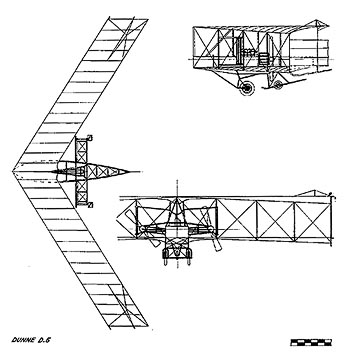 Dunne 5, 3view
Dunne D.5, March 11, 1910: World's first swept-wing. Unusually stable, even at very low speeds, this and the later monoplane version (D6) will help stimulate ideas some thirty years later. Designed by John W. Dunne and built by Eustace, Oswald and Horace Short.
1915 : Short Admiralty Type 184 (also ...Short S.184 / Short 225)
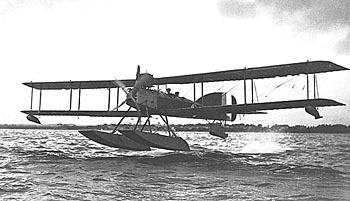 Short Admiralty Type 184 / Short S.184 download a 750pixel image
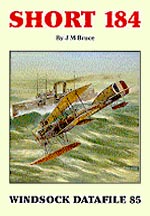 Short S.184 : Windsock Datafile 85
Short S.184 : Windsock Datafile 85http://www.flyingsites.co.uk The enigmatic if somewhat ungainly Short 184 gets the full Datafile treatment as authority Jack Bruce turns the spotlight on the famous First World War British seaplane. Serving from 1915 right up to the Armistice and beyond with both the RNAS and the RAF the Short 184 claims to have been the first ever aeroplane to torpedo an enemy vessel in action. One aircraft was at Jutland and parts of this aircraft survive to this day at the Fleet Air Arm Museum at Yeovilton.
Short Admiralty Type 184 / Short S.184 Produced in 1915 as the Admiralty Type 184, but more commonly referred to as 225s due to the horsepower of the initial powerplant, the Short Seaplane established the Short brothers' reputation as designers of first-class seaplanes.
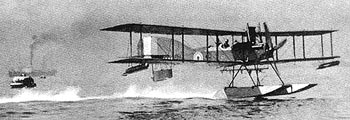 Short Admiralty Type 184 / Short S.184 download a 750pixel image
The Admiralty Type 184 was extensively used during the First World War. One even made history during the Dardanelles campaign when it became the first aircraft in the world to sink an enemy ship at sea by means of a torpedo.
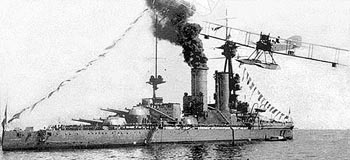 Short Admiralty Type 184 / Short S.184 download a 750pixel image
Short Admiralty Type 184 / Short S.184 http://www.adfa.edu.au The submarine threat soon forced Ark Royal to return to Kephalos where she served as an aircraft depot ship. On 12 June 1915 a newer, faster carrier, the Ben-My-Chree arrived, carrying two scout and three Short [Admiralty Type 184] seaplanes.
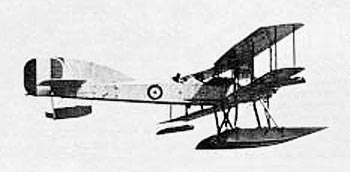 Short Admiralty Type 184 / Short S.184
The Shorts were equipped as torpedo bombers and on 12 August 1915 a 5,000 tonne supply ship became the first victim of an aerial torpedo. During the Gallipoli campaign, seventy air attacks were made on enemy shipping, including five with torpedoes, and 1,155 bombs, weighing 27 tonnes, were dropped.[26] 26. Jones, The War in the Air, Volume II, pp. 52, 56, 64-65, 72
On August 12, 1915, the HMS Ben-my-Chree launched a Short S.184 seaplane to attack a 5,000-ton Turkish supply ship in the Sea of Marmora. Although a torpedo hit the ship, the kill was awarded to a British submarine which had launched its own torpedoes at the same time.
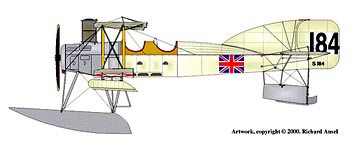 Short Admiralty Type 184 / Short S.184 download a 750pixel image
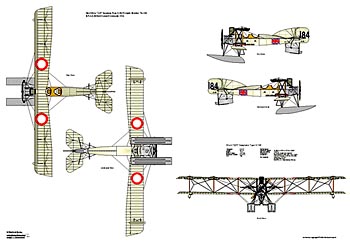 Short Admiralty Type 184 / Short S.184 download a 1000pixel image
Short Bomber
 Short Bomber, 1916 download a 750pixel image
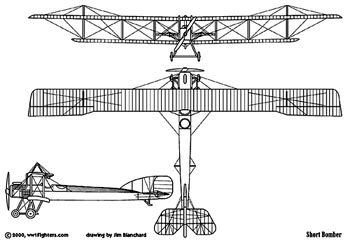 Short Bomber, 1916 download a 750pixel image
Nation : Britain Manufacturer : Short Brothers Type : Bomber Entered Combat : 1916 Engine : Rolls-Royce Eagle III 12-cyl. liquid cooled inline V, 250 hp Wingspan : 85 ft. (25.91 m) Length :45 ft. (13.72 m) Height : 15 ft. (4.57 m) Weight (Empty) : 6,800 lbs. (3,084.5 kg) Weight (Gross) : Speed : 77.5 mph at 6,500 ft. (125 km/h at 1,981 m) Ceiling : 9.500 ft. (2,896 m) Endurance : 6 hrs. Range : Armament : 1 machine gun & 920 lbs. (417.3 kg) of bombs Crew : 2 Further Reading : Whitehead Torpedo : as used on August 12, 1915 From Webster's Revised Unabridged Dictionary (1913) Whitehead torpedo \White"head` tor*pe"do\, or Whitehead \White"head`\, n. A form of self-propelling torpedo.
An important aerial advance occurred when airplanes progressed to the point that they could sink ships and submarines. During World War I, Germany developed submarines, or U-boats, into major offensive weapons. In response, airplanes developed techniques to disable and sink boats and submarines in the water. The first time a ship was sunk by a plane launching a torpedo was on August 12, 1915, when a British Short Admiralty Type 184 dropped a fourteen inch Whitehead torpedo and sunk a 5,000 ton Turkish supply ship.
Further Reading : Airships
The story of the British airship R-100 is actually a story of two aircraft; the R-100 and the R-101. The largest British airships built and the last, the R-100 and R-101 were the result of a large-scale scheme to link all parts of the British Empire, including Canada and a route to India and Australia. Called the 1924 Airship Plan, it called for the design and construction of two competing designs; one built by the Goverment funded Royal Airship Works, the R-101, the other by private venture, a division of Vickers Aircraft, the R-100.
 Airship Guarantee R-100 http://www.ultratech.net/~davtow/picoweek.html
Rather than being sisters, then, the R-100 and R-101 were more akin to cousins. The program went overbudget and fell several years behind schedule, (the airships were planned to be flown within three years), however the R-101 flew two years late with the R-100 flying two months after that. The R-101, the most ambitious of the two ships, suffered a number of technical failures and drawback that, it is felt, led to her demise on October 5, 1930, when she crashed in France and burned. Airship Guarantee R-100 Specifications
The R-101 used five heavier diesels. For some reason known only to the British Government of the time, the petroleum petroleum of the R-100 made her "unsuitable" for operation in the tropics because of the increased risk of fire -- in spite of the fact of over 5 million cu ft of highly inflammable hydrogen aboard her. As a result, the R-101 was to be used for the India route with the R-100 being delegated to the cooler Canada run. Design on both ships was begun in October 1924, with the first flight of the R-100 taking place on December 16, 1929, three years behind schedule. Although smaller and initially lighter 1 than the R-101, the R-100 was 11 mph faster at 81 mph and had double the passenger capacity 100 and 75% more lifting capacity. After numerous tests and demonstrations, the R-100 was flown to Canada in July / August 1930, mooring at St Hubert, Montreal at a previously constructed mooring tower configuration. R-100 spent several weeks displaying the supremacy of the Empire to the colonies, flying around the Montreal area and even made flights over Toronto. On her return, the R-100 did not fly again. The fatal crash of the R-101 proved to seal the R-100's fate. As previously mentioned, cousin R-101 suffered a fatal and catastrophic structural failure that led to her crashing and burning in a field in France, killing forty-eight persons on board, including Lord Thompson, head of the program, Sir Sefton Brancker, Director of Civil Aviation, R B B Colmore, head of the Airship development and the designer, Vincent C Richmond. After the demise of the R-101, the the R-100 was grounded and permanently and, finally in November 1931, was broken up, ending British Rigid Airship development for all time. In spite of the R-100 being a more successful design than the R-101, she still fell short of many of her design parameters and, after all was assessed, was felt she would not be able to achieve all that the planners had set forth in the 1924 Programme. Had the program concentrated on one design, rather than having two competing designs, the program would surely have moved more swiftly and met more of its design parameters. Note 1 The R-101 as built originally had an empty weight of 201,590 lbs but was lengthened to accommodate a 16th gas cell to improve performance, bringing her weight up to 235,189 lbs. also...
British Airships
Deux grands dirigeables
|
© Copyright 1999-2002 CTIE - All Rights Reserved - Caution |